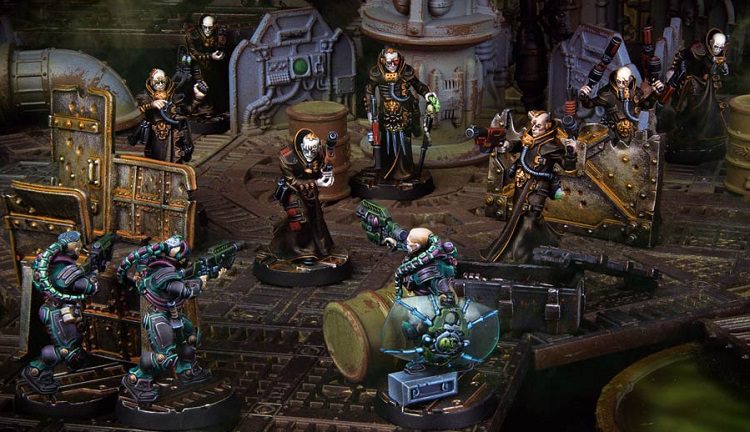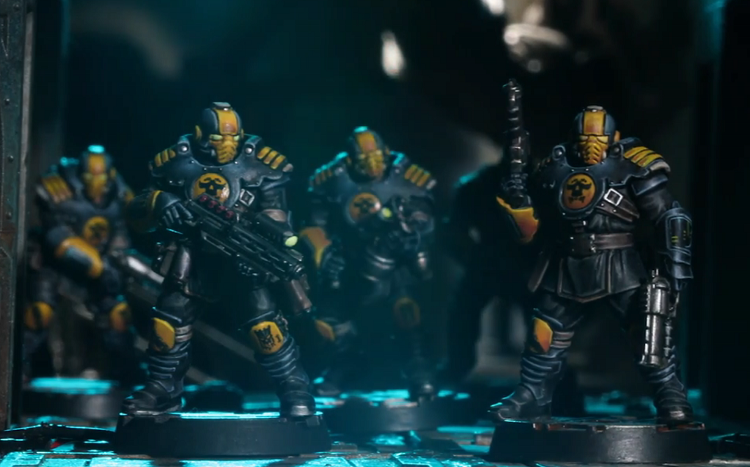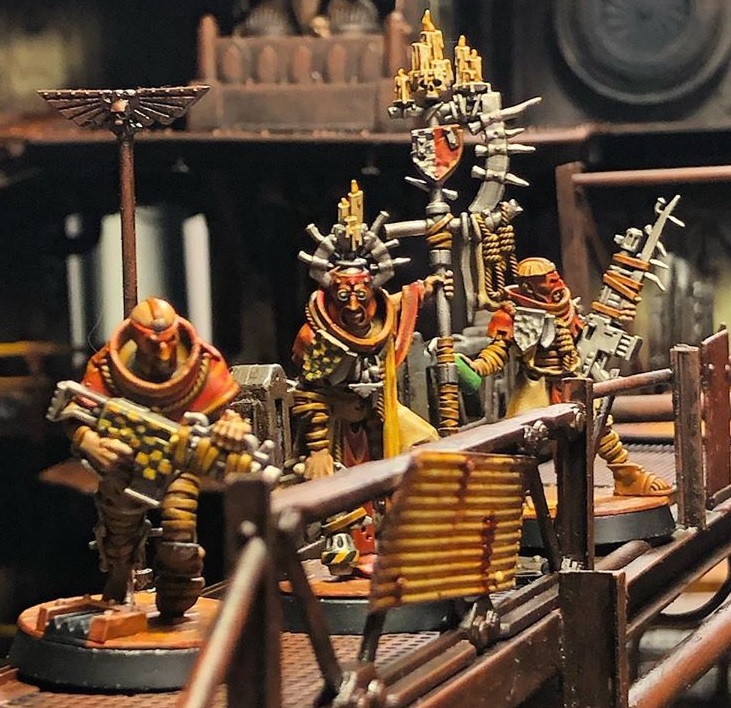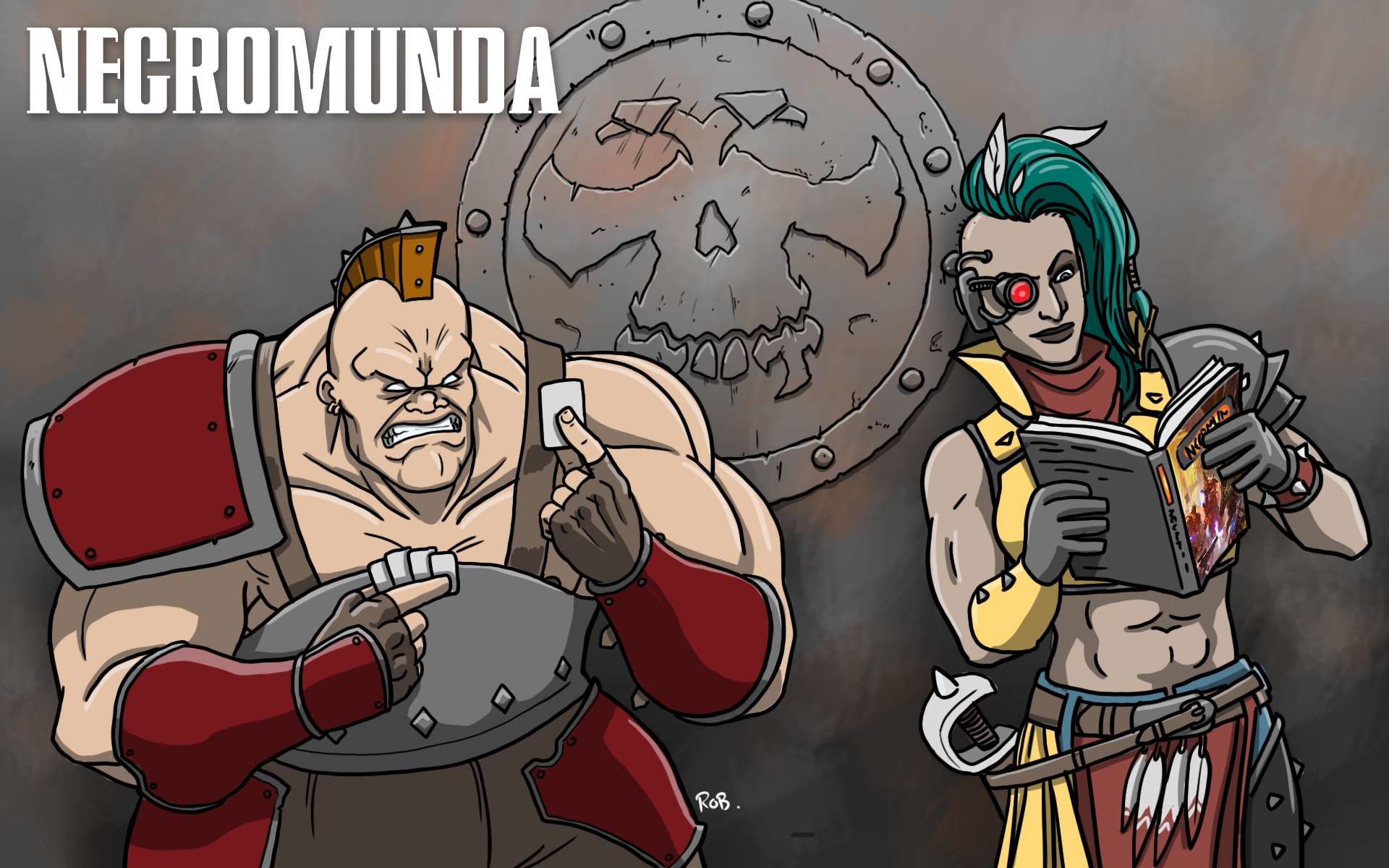Happy ‘munday, Scummers! This week we’re here to delve into the vastness of the Open Hive War Deck, a way for you and your pals to procedurally generate Scenarios in Necromunda! These games might not have the narrative flavor of some of the Scenarios we’ve already covered, but the unique challenges in randomly generated gameplay will require new and inventive strategy every single time. Let’s dive in!
The Open Hive War Deck is a nifty little pack that dropped the same weekend as House of Blades, and it’s essentially a pseudo-random scenario generator for Necromunda. Remember the old Open War cards for Warhammer 40k? They’re back, in Underhive form!
Each scenario is frankensteined together out of twelve Objectives, twelve Deployment Zones, twelve Perils, and each player picks one of twelve secret Loot goals, making for a deck that technically adds slightly over two hundred and twenty-eight thousand possible new missions to the game.
Sure, we’ve spent some time talking about All The Missions (1) in the Game So Far (2), but that’s apparently only 0.01% of the gross total nowadays, thanks to these cards. We’d have to be crazy not to cover this deck!

Table of Contents
Open Hive War
The Open Hive War deck (to be referred to as the OHW moving forward) comes in 5 parts: instructions, Deployment Maps, Objectives, Loot, and Perils. Using the OHW deck is easy! Simply draw one Deployment Map, one Objective, and one Loot card for each player that they keep secret until they’re scored, and one Peril. Instant Scenario!
After reading through these, our initial take is that they’re actually really good! There are a couple of gotchas, which we’ll get into later on, but all in all, it’s a good system. The rewards are decent and balanced, the Objectives are well-crafted, and while some of the deployment maps are a little silly, they will cause players to use unconventional and unfamiliar tactics to win.
Additionally, the Perils sub-deck forces players to add Badzone-esque hazards to their games, which is something that we’ve recommended fervently in the past.

Deployment
Of the four sub-decks in the OHW, the deployment sub-deck is easily the most impactful. There are twelve different maps, and most Necromunda players will be intimately familiar with roughly four of them.
Normal Deployment
7 of the 12 Deployment maps are new and interesting takes on Deployment, but don’t include special rules for the game. That doesn’t mean they’re not interesting, though, because a lot of these will be unfamiliar setups to most Necromunda players. Three of these maps start the gangs right in the center of the battlefield where things will no doubt get very bloody very quickly!
Crew size is determined by battlefield size with 3’x3’ or larger netting a Custom Selection (12) crew size, and 2’x2’ or smaller getting a Custom Selection (8) crew size. The Attacker in these missions always sets up their whole gang first, which might be a balance problem. It could be that in a lot of these cases, especially where the gangs set up on top of each other, it is too easy for the Defender to get the drop on the Attacker.
Reinforcements
3 of the 12 Deployment Maps are reprints of 3 of the normal maps with the Reinforcements keyword added. The players must select at least half of their gang and place them into their Reinforcements deck. During the End Phase of the second round D3 fighters will arrive at the battle using the Reinforcements rules from the Necromunda Rulebook. This is a great addition because Reinforcements can really spice up a game using a more “familiar” deployment map.
Sneak Attack
Finally, the last two Deployment cards have the Sneak Attack keyword. These missions will use the Sneak Attack rules as described in the Necromunda rulebook. The Defenders act as Sentries, moving randomly and slowly while on patrol, and the attackers get to sneak in and attempt to fulfill their mission before the Defenders get wise. Unlike previous Sneak Attack scenarios, though, OHW objectives cannot be scored until after the Alarm is sounded in s Sneak Attack game, meaning that the Defender will at least get a rebuttal.
We here at Necromunday love this part of the OHW. Sneak Attack games are usually a ton of fun, and unfortunately rarely get played. Most of the objectives in the OHW deck mesh well with the Sneak Attack format, but be careful for a Home Turf game using the Turf War objectives: it’s basically unwinnable for the Defender. However, if you’ve run into this combination in preparation for your game, simply draw another objective, and you’ll be good to go! Additionally, the Escape the Dome objective doesn’t mesh well with Turf War or Ambush, so if you get either of those combinations, go ahead and draw again!

Objectives
The Missions
All twelve of the deck’s Objectives generally fall into four distinct styles. Some exist as variations on the same theme separated by a degree of completion or urgency, while others are a pure test of a gang’s capacity for violence.
Deathmatch
Kill ‘em all, kill most of them, or kill ‘em the quickest! Most similar to Stand-Off and Tunnel Skirmish.
- Survival of the Meanest: Be the gang with the most fighters left standing after nine rounds.
- Last Gang Standing: The game keeps going until only one side has any fighters remaining on the battlefield.
- A Lesson in Pain: The Attacking gang has six rounds to kill or Seriously Injure at least half of the opposing gang, or the Defenders win.
Point Control
Take hold of multiple static objective markers, and blast any enemies who get too close! Most similar to Takeover.
- Burn Them Out: Defenders attempt to stop Attackers from claiming three objectives in the Defenders’ Deployment Zone.
- Tunnel Clash: Gangs fight to control two of three objectives arrayed in the center of the battlefield at the same time, for multiple rounds.
- Flank ‘Em: Gangs fight to control both of two objectives placed on opposite sides of the battlefield at the same time, for multiple rounds.
- Rush ‘Em: Gangs fight to control both of two objectives placed on in each of their deployment zones at the same time, for multiple rounds.
King of the Hill
There’s only one objective that matters, and that’s where your gang’ll be. Get to it, stat, and keep those other losers away! This archetype is, surprisingly, brand new to Necromunda.
- Turf War: Objective in the center of the battlefield, be the only gang with fighters within 8” of it during any End phase after round three.
- King of the Hive: Objective in the center of the battlefield, must be held for multiple turns.
- Critter Hunt: Like King of the Hive, but every time the objective is claimed, it scurries away 3d6” in a random direction.
Hold the Line
A frenzied escape or a vicious assault, depending on your current arsenal or point of view. Hopefully not too similar to Ambush or Show of Force.
- Escape the Dome: Attackers must flee the battlefield by reaching an edge chosen by the Defenders with at least three fighters.
- Killbox: Attackers attempt to force Defenders off of any ground 6” or closer to any battlefield edge.
The Rewards
There’s not as much to discuss with Rewards for winning these scenarios, and that’s kinda a good thing! We’d much rather see credit and reputation gains somewhat standardized across the board when one mission is just as likely as another to pop up randomly, and the deck does a good job of keeping things internally balanced in that respect. Credits given to a winning gang are generally 2d6x10, with a single pair of exceptions at 1d6x10 (Last Gang Standing) and 3d6x10 (Critter Hunt).
Furthermore, the deck revives a design mechanism rarely seen outside of Scenarios ‘ported over from the old Gang War books, and provides a consolation prize of credits to losing gangs!
It’s only 1d6x10 credits, but anything helps, and it’s always nice to at least have a little bit of change to buy some new gear instead of straight bupkis.

Loot
If you’ve been using Subplots for your gang regularly, or have experienced Intrigues in a Law & Misrule campaign, Loot cards will seem like a natural addition to the deck. If you’ve been skipping out, too bad! Loot cards are here, they’re a mandatory part of the Open Hive War system, and they’re just plain fun so you should probably start using Subplots outside of this, anyway!
Each player draws a single Loot card, keeping it secret if possible, to be revealed only when the conditions necessary to complete them are finished. For some, like Kidnap Job, it’ll be pretty clear which one you have immediately when you start the game by placing the required Hive Dweller NPC on the battlefield. For others, like The Challenge, there’s no way for your opponent to know that you’ve been gunning for their champion just because you’re tired of dealing with their Heavy Stubber, or if you’re secretly going to score a bonus of 1d6x10 credits for bringing them down.
Although slightly more than half of the Loot conditions hinge on dealing damage to the enemy, the rest can be accomplished simply by being in the right place at the right time. The previously mentioned Kidnap Job, for example, grants 2d6x10 credits when roughly escorted from the center of the battlefield to an edge.
Gangs who’ve drawn one of these non-combative Loot cards and are faced with an unbeatable opponent can easily decide to mitigate their losses by focusing on these secondary objectives and then vamoosing with a quick Voluntary Bottle.
The cards are mostly balanced against each other in terms of difficulty to complete and rewards given, all hovering in the range of 1 or 2d6x10 credits gained and maybe the occasional +1 Reputation. The only outlier is the confounding trio of Wipe Them Out, Finish Them Off, and Loot Their Corpses, which offer the same 1d6x10 credit reward for a task that’s functionally identical, only with a series of exponentially more specific restrictions tacked on for each one down the line.
- If you are playing with Subplots or Intrigues, know that there’s nothing explicitly stopping players from running one of those and a Loot card. It won’t break the game or anything if players choose to do so, but it will add on an extra thing to keep track of and has been previously called out as a point of concern by the developers.

Perils
This is where all of your best-laid plans fall to pieces. You’ve learned your mission, scoped out where you’ll deploy, and even figured out a little hustle to earn a bit extra on the side. Then, the ground starts to shake…
Perils cards are remarkably similar to, you guessed it, our favorite Badzone Events from the Book of Peril. Unlike the ones in the Badzones, however, these Perils stick around for the entire game once drawn, instead of randomly changing from round to round. They’ve also elected to eschew some of the especially nasty ones, so you’re in luck if you weren’t looking forward to dealing with another Static Storm or an entire game avoiding an errant Mutie Tribe.
That’s not to say that even a single one of these cards isn’t vicious in its own right! Poisoned Air makes Move a basic action unless a fighter has a Respirator, and Pitch Black simply turns out the lights for the entire game. Our favorite Peril is one that’s not an adaptation of an existing Badzone Event, Hive Plague, which causes d3 fighters from each gang to start the game with a Flesh Wound.
You can’t plan for something like that!

Can I Even Buy This Deck?
Not really! The release and continued availability of Necromunda cards have historically been a sore point for most of the player-base, and with good reason. Cards are historically printed exactly once, and once they’re cleared out of the Games Workshop warehouse you’ll be stuck either paying double or more on eBay, or getting lucky and finding a pack at some out-of-the-way local game store.
In this case, the Open Hive pack was Direct Only, so local stores wouldn’t be getting many (if any), and at the time of writing this article, the lowest eBay listing is currently at US$75.
Bleh.
Don’t Worry! There’s A Way.
On the off-chance that you didn’t spend your entire morning a few Saturdays ago frantically F5ing Games Workshop’s web-store like you were trying to buy Taylor Swift tickets (like we did, naturally), there’s still a way for you to enjoy the beauty of Open Hive War!
An industrious member of the community, snOlan, has taken it upon himself to create a fully fledged card generator. It’s a slick little resource that makes a relatively unattainable product accessible to the masses. Necromunda’s always had a small but devoted fan-base, and nowhere is this clearer than when folks take it upon themselves to make sure that everyone can enjoy even the, ah, “harder to acquire” aspects of the game.
Click here for the Open Hive War Generator!
You can create a randomized scenario virtually identical to the ones out of the deck, and it even hides the two Loot cards by default for if you’re playing against someone who might be inclined to peek and use that illicit information to their advantage. Keep searching for those physical cards, if that’s your bag, but in the meantime everything you need is right here!

Arbitrator Adjustments
As much as we love the cornucopia of possibilities that this deck allows, they’re not going to be a complete substitute for the existing official scenarios, which are balanced (at least somewhat) and designed to tell a specific story. We’re not going to throw our Alternate Scenario Tables in the trash for this deck, but we’re likely going to implement it somehow!
For the time being, we’ll be allowing Open Hive War scenarios to be rolled up whenever the players are able to select their own mission, with an important caveat to the official methods:
- The player with the lower Gang Rating always selects whether they are the Attacker or the Defender.
As mentioned earlier, the Attacker sets up their whole gang first in every OHW scenario. This might turn out to be a very bad thing in some deployment maps, so we’d suggest adjusting this by one of two ways:
- The Attacker always gets priority in the first round, or
- Instead of deploying their whole gang, the Attacker places one model, then the Defender places one, then the Attacker, and so on.
Although we’re huge suckers for Absolute Randomness, we will begrudgingly accede that our players may not want to spend their evenings playing out a dealt hand that doesn’t look like it’s going to fun for one or both of them. To this end, we’ll be tamping down on the luck of the draw slightly by over-dealing and allowing our players limited veto rights:
- When generating an Open Hive War scenario, players will draw three cards for Deployment. Each player will choose one card and return it to the deck, starting with the player with the lower Gang Rating. The remaining card will be the Deployment Zone played. Repeat this process for choosing Objectives. Loot and Perils cards will be randomly drawn as normal.
Finally, we’re going to go out on a limb here and assume that a single extra Tactics Card for the outmatched gang is hardly going to even the odds. At a bare minimum, it should be one per 1– credits in Gang Rating difference, like the other scenarios do. We tend to give our Underdogs a lot more, so check out the other methods available if you’re looking for a fairer fight.

Conclusion
To be honest, we were a little bit skeptical about the Open Hive War deck. Necromunda’s awfully complicated, and a lot of the work GW has done on Scenarios for Necromunda have unfortunately fallen flat. But, the OHW deck is actually really, really good! The Deployment maps are fun, the Objectives work, the rewards are fair, and the Perils system totally rules! We would definitely recommend that Arbitrators add some Open Hive War games to their current or next campaign.
We think our adjustments will make the deck work better, but feel free to drop us a line over at necromunday@goonhammer.com with your thoughts and experiences!
There you have it, Scummers. Another fun edition to our favorite skirmish combat game! Make sure you eat a big meal next Sunday, because you’ll want to bulk up for when we revisit Slave Ogryns from the House of Chains and all their new tricks! Until then, Scummers!


